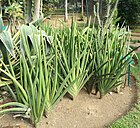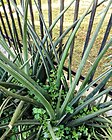Note: This is a project under development. The articles on this wiki are just being initiated and broadly incomplete. You can Help creating new pages.
Sansevieria - Muruva
Sansevieria is a genus of about 70 species of flowering plants. It is native to Africa, Madagascar and southern Asia and it's subfamily Nolinoideae. It has also been placed in the former family Dracaenaceae.
Contents
- 1 Uses
- 2 Parts Used
- 3 Chemical Composition
- 4 Common names
- 5 Properties
- 6 Habit
- 7 Identification
- 8 List of Ayurvedic medicine in which the herb is used
- 9 Where to get the saplings
- 10 Mode of Propagation
- 11 How to plant/cultivate
- 12 Commonly seen growing in areas
- 13 Photo Gallery
- 14 References
- 15 External Links
Uses
Ringworm, boils, infected sores, cuts and grazes, fungal infections, scabies infections, cough, bronchitis, traumatic injuries
Parts Used
Rhizomes, leaves, Shoots, Root stock.
Chemical Composition
Phytochemical screening of water and ethanol extracts yielded alkaloids, flavonoids, saponins, glycosides terpenoids, tannins, proteins, and carbohydrates.[1]
Common names
| Language | Common name |
|---|---|
| Kannada | |
| Hindi | |
| Malayalam | |
| Tamil | |
| Telugu | |
| Marathi | NA |
| Gujarathi | NA |
| Punjabi | NA |
| Kashmiri | NA |
| Sanskrit | |
| English | Snake plant |
Properties
Reference: Dravya - Substance, Rasa - Taste, Guna - Qualities, Veerya - Potency, Vipaka - Post-digesion effect, Karma - Pharmacological activity, Prabhava - Therepeutics.
Dravya
Rasa
Tikta (Bitter), Kashaya (Astringent)
Guna
Laghu (Light), Ruksha (Dry), Tikshna (Sharp)
Veerya
Ushna (Hot)
Vipaka
Katu (Pungent)
Karma
Kapha, Vata
Prabhava
Habit
Identification
Leaf
| Kind | Shape | Feature |
|---|---|---|
| Simple | linear | The blades are transversely banded with contrasting green and whitish zones |
Flower
| Type | Size | Color and composition | Stamen | More information |
|---|---|---|---|---|
| Unisexual | 5 mm long | greenish white | 5-20 | Flowers Season is June - August |
Fruit
| Type | Size | Mass | Appearance | Seeds | More information |
|---|---|---|---|---|---|
| subglobose | 7-9 × 5-8 mm | Fruits are subglobose to oblong-ellipsoid | bright orange | - | {{{6}}} |
Other features
List of Ayurvedic medicine in which the herb is used
- Vishatinduka Taila as root juice extract
Where to get the saplings
Mode of Propagation
How to plant/cultivate
Sansevierias are succulent plants and so need a well-drained compost and moderate watering. In the summer months they can be watered frequently and appreciate this, as long as the soil does not remain water-logged, but in the cooler months they are best left dry. A minimum winter temperature of 10°C is recommended. Short periods of lower temperatures may however be tolerated as long as the plants are dry.[3]
Commonly seen growing in areas
Trophical region, dry soil region.
Photo Gallery
References
External Links
- Ayurvedic Herbs known to be helpful to treat Ringworm
- Ayurvedic Herbs known to be helpful to treat boils
- Ayurvedic Herbs known to be helpful to treat infected sores
- Ayurvedic Herbs known to be helpful to treat cuts and grazes
- Ayurvedic Herbs known to be helpful to treat fungal infections
- Ayurvedic Herbs known to be helpful to treat scabies infections
- Ayurvedic Herbs known to be helpful to treat cough
- Ayurvedic Herbs known to be helpful to treat bronchitis
- Ayurvedic Herbs known to be helpful to treat traumatic injuries
- Herbs with Rhizomes used in medicine
- Herbs with leaves used in medicine
- Herbs with Shoots used in medicine
- Herbs with Root stock used in medicine
- Herbs with common name in English
- Habit - Perennial plant
- Index of Plants which can be propagated by Seeds
- Index of Plants which can be propagated by Cuttings
- Herbs that are commonly seen in the region of Trophical region
- Herbs that are commonly seen in the region of dry soil region
- Herbs






